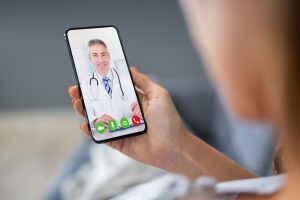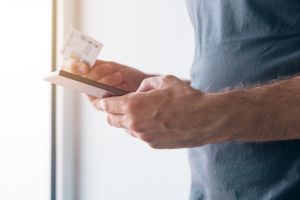06.05.2020 г.
Philosophy of lock-down: how remote identification is supporting us during this challenging time
Self-isolation will certainly come to an end quite soon; according to experts, the virus most probably will continue to live next to us, mutate, and we will have to put up with this somehow. And while humanity is waiting patiently, new consumer habits are forming all by themselves. Services and applications that until recently were considered non-core, are coming to the fore.
Many services that we use on an everyday basis can only be received after identity confirmation, which involves verifying a passport or an equivalent ID document. Even though we are witnessing an active transition to digital, especially when it comes to state and local government organizations, as well as financial and insurance sectors, the customer service still requires a passport checked by the authorized company representative. But what can we do when we need to use banking, insurance, notary, or telecom services but are not allowed to leave the house? Remote identification is the answer.
Some facts about remote identification
Remote identification involves several consecutive actions, which are: ID recognition and its authenticity verification along with verification of the user by doing a selfie-check. The main difference of document identification from biometric identification is that biometrics (fingerprint stamps, retina pattern, DNA sample, and voice sample) require the creation of a complex infrastructure for personal information collection and transfer, as well as its protection.
In case when biometric data gets compromised and becomes easily accessible to someone other than its owner, it will be extremely hard to replace, since our biometrics will remain with us, unchanged, for the rest of our lives. It is probably for that reason most banks have been slow in implementing biometric identification.
Remote user identification through mobile or web ID recognition allows us to solve problems that we normally solve using the 20th-century methods, that is: by contacting the organization by phone or going to the office. Today, many things can get done without leaving the couch: ordering pizza, groceries, or home essentials. In large cities, online delivery has long become a daily thing, as for remote locations, this is relevant only for those sectors that could switch their activities to digital during the pandemic.
Calling an ambulance and seeing a doctor

Remote recognition of documents could facilitate the work of emergency medical services: the app with an integrated automatic recognition of a passport or medical insurance policy can speed up patient service. No need for the client to spell out their full name and other personal information to the operator through the phone, or fill out numerous forms manually. The fact that there are no such services yet, not that we know of at least, is a shame since they could unload the dispatch service.
In telemedicine, remote patient identification is a necessity, since a doctor on the other side of the screen has to clearly understand who is in front of him, what’s their medical history, and of course be confident that the patient is who he says he is, and not someone else who had access to the account, with or without malicious intent. Those organizations that provide medical services responsibly know what we are talking about, since they have installed the identification technologies into their online or web applications, and use it each time a patient seeks help; medical data is extremely sensitive and health service companies receive significant fines if it gets compromised, not to mention reputation damage.
Buying SIM cards

Staying connected through mobile communication is important for many of us, especially in time if self-isolation. Until recently, one had to visit the telecom shop, bring their passport with them and personally sign a contract with the operator. Today, a lot of mobile operators offer remote self-registration, which involves recognition of a passport, its verification, fraudulence check, and verification of identity (comparing a person’s face to a photo in their passport, or as they call it – a selfie-check). All this data is processed by AI. After that, the card can be delivered to your door.
Taking a bank loan
Getting a loan without leaving your home can also be challenging. There are a few banks that issue loans through personal accounts, however only to those clients that have a payroll card with that bank, and have previously confirmed their identity by going to the bank, or have submitted their biometric data. Several financial institutions (some banks and microfinance institutions) are already implementing software modules in their applications that allow them to remotely process applications from new clients. Interesting how those services that until recently were used in the testing mode, suddenly came to the forefront.
Registering as self-employed
Many have lost their jobs during the COVID-19 pandemic since large enterprises experience downtime and small businesses were unable to stay afloat and had to close down. On the bright side, in some countries it is possible to get registered as self-employed and start your new remote job perfectly legally. For example, the registration process takes less than 10 minutes, which can be completed through the national tax service website, and involves scanning the applicant’s passport, which gets automatically recognized from the camera of a smartphone, tablet, or PC. Lastly, you would need to take a picture of your face with your passport next to it, to confirm your identity. Notice that no biometric data is required here.
The evolution of identification
Government authorities are seriously considering equating a mobile phone to an identity card. Many telecoms, insurance, financial and health services, have long been using mobile identification and phone numbers as part of two-factor user authentication. Smartphones allow protecting user data with a password, fingerprint, retina pattern, and 3D model of the face. It seems like there is no technical difference between presenting an identity document to the camera of a smartphone and showing it to a servicing manager at the office; however it takes less than a second for machine vision to recognize the data, and minutes to type it manually. Furthermore, the human factor plays a large role in most data leaks. Fortunately, AI-based document recognition systems of the latest generations make far fewer errors than humans.
Freedom or slavery?
Well, lockdown is not what you call freedom. It is a rather constant dependence on digital devices, attachment to a computer, mobile phone, TV, gaming console, which forms some, albeit quite convenient, digital slavery. But the paradox is that the opportunity to gain access to services that are normally only available offline after voluntary self-identification (by presenting your passport or showing your face to the camera of the device) is empowerment in a way, a step towards maintaining your normal life even during difficult times like these.
Other blog posts
06.03.202303.03.2023Smart Code Engine: Revolution debit and credit card scanning technology
11.11.2022Stolen passport photos, fraudsters and facial fusion technology pose a threat to national security
All posts »